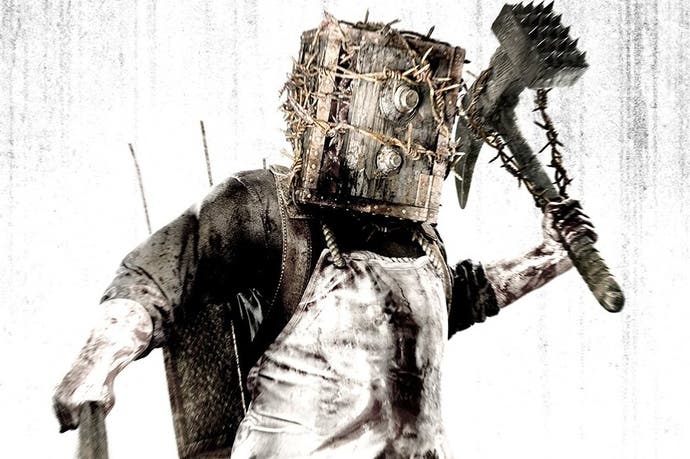Face-Off: The Evil Within
Engine trouble.
The Evil Within is a good game, possibly even a great one, but what's clear after a few days' testing is that it suffers from technical issues which prevent it reaching its full potential. Despite being built using id Tech 5, an engine conceived to deliver 60fps on all formats, the game has genuine issues even hitting 30fps - and that's factoring in the mammoth 'cinematic' borders that vacuum up almost 30 per cent of the screen real estate.
As we observed in our performance analysis, the game essentially operates at a native rendering resolution of 1920x768 on PS4 and 1600x640 on Xbox One, which is really just 1080p vs 900p with those large black bars inserted. The dynamic resolution scaling seen in Rage and Wolfenstein: The New Order is gone, so we're looking at a fixed framebuffer on both consoles backed up with what appears to be standard FXAA to tackle aliasing.
The basic anti-aliasing technique does a reasonable job eliminating edge aliasing, but on Xbox One the combination of an upscaled image with FXAA and heavy post-processing results in a rather blurry experience. A soft-focus depth-of-field effect is also utilised throughout, which also cleans up distant pixel shimmering. Its intensity varies scene to scene, but the effect creates an interesting juxtaposition between high-contrast foreground objects and soft-focus background elements. Combined with the narrow field of view, the game does indeed deliver on its cinematic aspirations with some beautifully framed sequences but, unfortunately, this comes at the expense of playability.
The PC, of course, offers a full selection of resolutions to boost image quality. Three types of post-process anti-aliasing (FXAA, SMAA and MLAA) are available, but we get the feeling they will fail to impress PC gamers - many edges are left untreated and image quality can be rough, while forcing MSAA through the GPU control panel doesn't seem to work as it did with Wolfenstein: The New Order. The narrow field of view of the console game is an issue on PC as well, but thankfully some resourceful users have been working hard to solve the problem. One user, Kputt, has released a FOV fix utilising Cheat Engine, while another user compiled those memory edits into a standalone executable available through Reddit. It works brilliantly and allows for on-the-fly adjustments that completely solve the FOV problem. (Flawless Widescreen has also been updated to support the game to similar effect.) That said, widening the display angle does seem to incur a performance penalty, so hitting 60fps may prove even more difficult. Away form the PC, it's unlikely the console versions will see any changes but, after they were patched into Resident Evil 6, there's always a remote possibility.
Alternative comparisons:
It's difficult to ignore the performance issues The Evil Within suffers from, but looking past the frame-rate reveals a very attractive game. Beautifully detailed maps are complemented by a selection of extremely high quality character models, lovely texture work and excellent post-processing. It looks a fair bit more impressive than any previous id Tech 5 title and possesses a unique aesthetic. The game also effortlessly weaves in and out of its entirely real-time cut-scenes and isn't afraid to attempt complex scenes that would be pre-rendered videos in many other titles. The presentation is wholly unlike anything else this engine has produced and feels uniquely Japanese.
The developers have taken things even further with a more robust lighting model than previous id Tech 5 titles. After focusing so heavily on lighting and shadow with id Tech 4, it was surprising when all of that was cast aside in Rage for a mostly baked approach, but Tango Gameworks seemingly took it upon itself to implement a dynamic lighting model and it looks excellent. Dynamic light sources all cast proper soft shadows, with multiple sources even casting overlapping shadows of varying intensity. Shadows themselves can appear a bit fuzzy at times with noticeable shadow jittering in certain cases, but the effect still looks great in motion. It's very likely that the addition of this new lighting model is at least somewhat responsible for the game's performance problems, but it really wouldn't look right without it. Shadow quality between the three versions is remarkably similar, however, which may be quite disappointing for enthusiast PC users with untapped GPU power in their rigs.
One aspect of id Tech 5 that remains in place is its MegaTexture technology. Virtual texturing has always been interesting from a theoretical standpoint, but in practice it has often produced ugly side effects, with some surfaces in Rage and even Wolfenstein resembling poorly compressed JPEG images. Clearly the advantage to this approach is texture variety, eliminating unnatural tiling and truly allowing the artists to go crazy with art design. From that perspective, The Evil Within delivers an even greater variety of artwork than its engine stablemates and seemingly does so with higher-resolution assets across the board. Tango has done a great job creating appropriately filthy surfaces - reminiscent of the Resident Evil remake in some ways - that manage to avoid the compressed image look and it often feels as though each room you explore features entirely unique artwork.


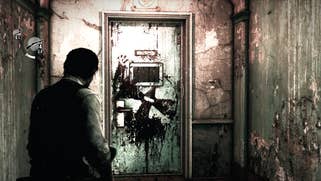
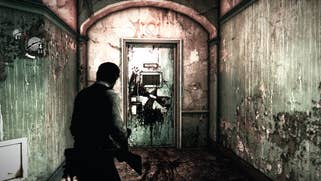
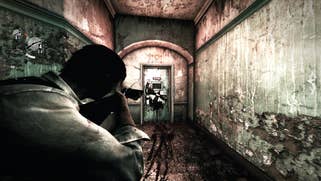
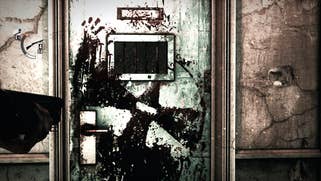
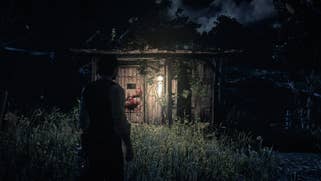

Of course, texture pop-in has always been an issue for id Tech 5, but The Evil Within handles it a bit better than Rage or Wolfenstein. You'll still note minor pop-in during quick cuts or after a loading screen, but in general texture detail never feels as if it's being drawn while you play. Interestingly the PC version doesn't have any significant advantage here as the consoles keep up remarkably well with minimal pop-in. Texture decoding was always a bit CPU-heavy, though a GPU option was available in Rage for Nvidia users, and it seems possible that some of the game's performance issues on consoles stem from this element of the tech.
Historically, load times have been another sticking point with id Tech 5. Thankfully The Evil Within fares a bit better on all three platforms. On the PC front, even from a platter drive, loading times are extremely quick and painless, lasting no more than five seconds on our setup, while installing the game onto SSD makes it difficult even to read the loading screen tips. On consoles, however, things don't fare as well, with most levels requiring 15-25 seconds to load. This becomes more of an issue if you die, as the game needs to reload level data at this point resulting in a similarly long load screen. It's much faster than the console versions of Rage and just short enough to prevent frustration setting in, but it certainly isn't optimal. It should be noted that the game weighs in around 40GB across the three primary platforms as well.
Looking at other elements, we see a lot of similarities between each version. The highest settings available on PC are basically equivalent to the PS4 version with a few minor exceptions. The depth-of-field used in certain cut-scenes, for instance, appears noticeably chunkier on PC and in select cases Xbox One. Looking at the intro we found the PC version seems to render objects passing outside of the police car at an obscenely low resolution resulting in a chunky appearance, yet during gameplay the subtle depth-of-field effect is actually somewhat less pronounced on PC, and indeed all three versions are slightly different in this regard. It does give the impression of increased distant texture detail on the PC at times, even at an equivalent resolution to the PS4.



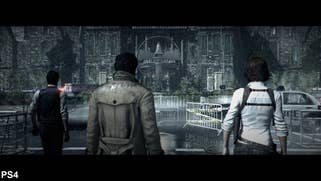
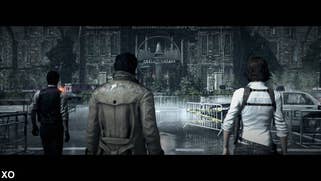
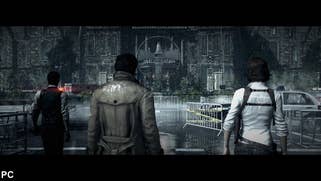



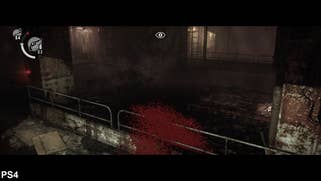
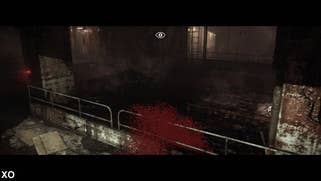

The updated engine also makes heavy use of specular highlights and we noted another minor difference between the versions here as well. We ran across a number of scenes where an appropriate specular effect on PS4 was missing on Xbox One and PC. Another minor difference is a slight change in the way SSAO (screen-space ambient occlusion) is rendered on PC. It's not always obvious in every scene, but the effect actually seems more pronounced - and not necessarily in a good way. Corners sometimes appear to collect thicker black blobs that seem, strangely enough, less precise than the effect on console.
Ultimately The Evil Within is a very nice-looking game on all three platforms (well, as nice as a game this gruesome can look, obviously), so it's a shame the performance falls short of expectations. As established previously, The Evil Within has consistency issues on both current-generation consoles while the PC version has severe scalability issues on higher-end hardware. Anyone considering buying the game on disc for PS4 should also make certain that the latest patch is installed, as out-of-the-box pre-patch performance is much worse. (We weren't able to test the Xbox One version without its patch, so we're uncertain if that's the case there as well.) There's a night-and-day difference with the latest update installed, but it still feels under-optimised and sluggish. We should point out that all of our performance analysis published to date is based on patched code.
The Evil Within's performance issues do not manifest in a typical fashion. Normally the inclusion of additional light sources or large numbers of enemies hammers frame-rate, but in this case performance seems tied to the map itself. Chapter three, for instance, produces similarly low frame-rates exploring the village free of enemies as it does during combat. The most demanding section we've run across isn't a large open battleground, but rather a small room tucked in the corner of a mansion at the beginning of chapter four. Clearly there is something wrong here, although none of this is to say that effects work can't drop the frame-rate further - for example, looking directly into an open fire had a noticeable impact on fluidity, particularly on the PC when running with the frame-rate uncapped.
As noted above, we also suspect texture decoding accounts for some of the problems. There are scenes that demonstrate massive dips in performance upon arrival only to return to locked 30fps moments later. We can't say for sure, but it certainly seems possible that the decoding process is bottlenecking the consoles' lower-power CPUs. All of these different factors combine with the narrow field of view and jittery camera motion, leaving the game feeling very inconsistent and jerky.
Then there's the issue with the Xbox One version we mentioned previously, which persists as of this writing. The game's renderer seems to be out of sync with the background simulation, producing a persistent stutter even when the frame-rate holds steady at 30fps. Anyone familiar with the frame-skipping issues present in a number of Bethesda-produced Gamebryo titles, such as Fallout 3 and New Vegas, will know exactly how frustrating this persist tic can be.
Looking at the PS4 and Xbox One versions side by side, the results are actually rather interesting. Ignoring the sync issues on Xbox One, the minimum frame-rate is often a touch higher than PS4. The moments that this occurs, however, seem to be tied to texture decoding where the PS4 appears to struggle a bit more. Once these hiccups are passed, performance between the two becomes closer. After playing through half the game on both platforms, we have to give the nod to the PS4 version when it comes to performance. Texture streaming can cause greater dips on PS4 but the overall performance is generally smoother, while the Xbox One version is stuck with a constant stutter that impacts any sense of fluidity.


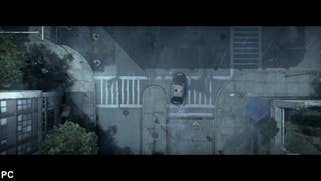
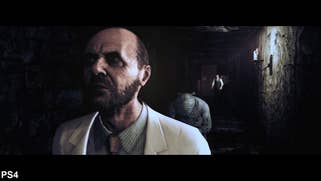

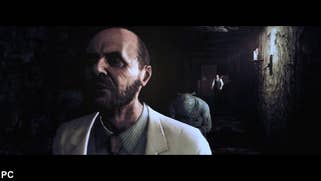




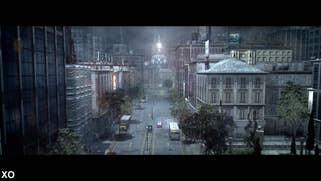

The Evil Within - the Digital Foundry verdict
Is this the end for id Tech 5? As it stands there aren't any other products in the pipeline with the engine behind it - that we're aware of, at least. Its utilisation has proven to be an interesting experiment and the fact that it produced two consoles games capable of holding a solid 60fps is impressive. However, The Evil Within clearly shows that it's not right for every development environment. The team at Tango Gameworks has made some impressive changes, with id's engine pushed in brand new directions, but we can't feel the underlying technology is ill at ease with the demands placed upon it.
Does The Evil Within manage to rise above its performance issues and live up to its potential? Well, yes, it's a solid and interesting game. Of the two console builds, PS4 gets the nod - the higher resolution is welcome and the game simulation is more closely linked to the renderer, meaning less stutter than the Xbox One version. However, while improved over the Microsoft console, the PS4 game still feels highly under-optimised. Indeed, as things stand, with the possible exception of Thief, The Evil Within probably has more performance issues than any other title we've tested on the new wave of consoles - and that's a real shame, as there's a remarkably good game here let down by its surrounding technology.
That being the case, those looking for something closer to the best possible experience should really opt for the PC version, provided you have the requisite hardware to at least match and exceed PS4 performance - a modern Core i3 processor matched with something like a Radeon R9 270 or a GeForce GTX 660 should get you to 1080p30 with a consistent performance level. Liberating the game from its overbearing borders and narrow field of view improves the experience, plus there's the opportunity to scale beyond 1080p for those who own higher-resolution displays. But even here, it's clear there are profound optimisation issues. We like to think of the PC as the platform capable of powering its way to the best possible gameplay experience, with 60fps gameplay a key component, but for now at least that's completely off the table, and that's a real shame.
